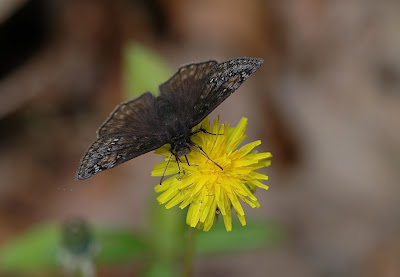The Eastern Tent Caterpillar (Malacosoma americana) is busy at work in April and May. Their tents are usually found in the crotch of Wild Cherry trees, but if no rose family trees are available they can be found on less nutritious species like this Beech. A few caterpillars are outside mending the tent, but most stay in a large clump when it rains. This generates body heat on cold days. Long wet springs can result in lower caterpillar populations, as they hate to feed in the rain. The Eastern Tent is considered only a minor pest because most trees will re-leaf after defoliation this early in the season.
Known for its distinct winter buds and edible fruit, the Pawpaw (Asimina triloba), has an interesting flower, but you have to catch it during the short blooming period. The dark maroon flowers are often overlooked. The flower parts are in threes. Three sepals, 3 outer petals, and 3 inner petals.
The flowers are not sweet smelling, but more closely resemble rotting flesh. It's only natural then that flies will be drawn to these plants. Pawpaw is the only northern member of the Custard-Apple family. Most species are tropical. Small-flowered Pawpaw, A. parviflora looks identical and is found in Florida. The other species of pawpaw in the south are all small shrubs with large WHITE flowers.
While Diptera (flies) are the known primary pollinators, I participated in a study of the small-flowered pawpaw with Dr. Norman of Stetson University back in the 80's. We also found four species of beetles associated with the flowers. Two Scarabs, and two Long-horned Beetles which were either petal or pollen feeders.
Other than the dull maroon, a little back lighting from the sun will show a nice red color to the flowers.
This is Morrow's Honeysuckle, Lonicera morrowii. This is one of four exotic invasive bush honeysuckles in our area. I hope to do a post on them all once I have enough photos. In the meantime, Morrow's shows these short blunt leaves very much like Tartarian Honeysuckle. Amur Honeysuckle L. macckii has very long pointed leaves. In Morrow's the leaves and twigs are very hairy, and Tartarian is (supposed) to be all smooth or glabrous. Flowers in these two vary from white to pink or red.
This is a confusing one. I have found one picture nearly identical to this labeled as Bell's or Pretty Honeysuckle, Lonicera x bella. The x means it is a hybrid between Tartarian and Morrow's. All parts of the plant were hairy, and it could be just a color variety of Morrow's. I have yet to find any source that discusses in detail an absolute morphological description of bella and how it differs from the parent plants. I don't believe flower color alone is reliable, so stay tuned.
Beautiful purple flowers and compound leaves are that of Greek Valerian. Sometimes called Jacob's Ladder, the names are interchangeable between two species. I prefer to use Greek Valerian. The important thing is the latin name, Polemonium reptans. The difference between them is often debated, are the stamens protruding past the petals or are they not. Here are pictures of two plants growing side by side. When the petals are not fully open it appears to have long ones sticking way out, not so when the flower is open. This is a comment I often hear when students are keying this out. Problem is, they are looking at the PISTIL instead of the stamens! P. reptans is the only wild species in our area.
Growing on drier hills or along roadsides is the Wood Vetch. Vicia caroliniana. The flowers may often be tipped with blue.
Wood Vetch may be mistaken for things like Canadian Milk Vetch or others, but the tendrils at the end of the plant are distinct. In Newcomb it keys as a vine.
Trying to figure out Dusky Wing Skipper butterflies are not easy. They are very 'skiddish' and hard to approach when on a flower.
Edit: I just came across what I believe is the Dreamy Dusky Wing, so I added it. Can you see the difference?
Moss Phlox, Phlox subulata. This is our smallest phlox, growing only a couple inches high. They form solid mats along the ground. The very linear leaves are clustered together and appear whorled. They can be pink to purple. Many other colors and varieties are sold in greenhouses.
These clusters of white bell like flowers are from a woody shrub called Bladdernut, Staphylea trifolia.
I believe I posted these once before, but I just found another large batch. The oddly shaped flowers and heavily dissected leaves make Wood Betony one of my favorites. Flowers range from yellow-brown to maroon.
As I mentioned when I started, I feel lucky to get shots of anything with all this rain. The rest of these are quite common, but right now beggars can't be choosers. Here is Wild Strawberry, Flowering Dogwood, Wild Geranium, and Fire Pink.























Excellent pictures! Adding that to commentary from you is like BlogBotany Geographic with practical applications! I mean it makes it so much more exciting to keep an eye out for the things you describe, for me, than to read about say? Mt Everest and know I'm never going there! Thanks for doing it!
ReplyDeleteI know what you mean Mike. Who needs Mt. Everest when there are so many local wonders. Your comments are appreciated.
ReplyDelete